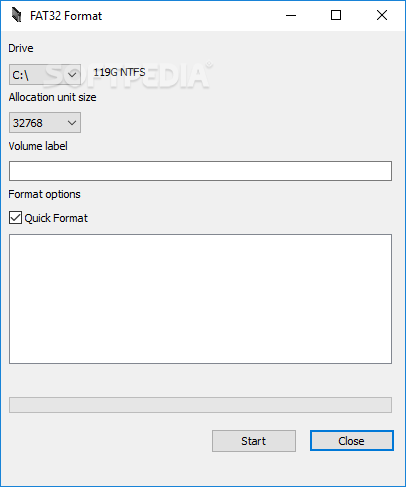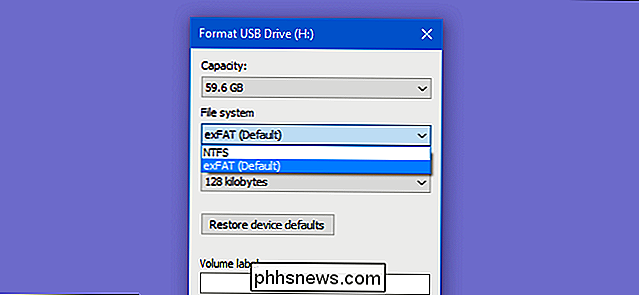-->
- 5th Lo and behold, guiformat did not throw an error, and formatted the full drive to 4tb. And there was much rejoicing. Only the last 2 steps may be important. Like I said I'm not really sure.
- When I shut down explorer.exe, I just got a completely black screen, can't even see the dekstop where guiformat is located:/ EDIT: I'm on Windows 10 and had to go to the 'details' tab to find explorer.exe, couldnt find it under 'processes'.
Definition
There are various free third-party Windows applications that can be used to format SanDisk memory cards in the FAT32 file system for use in devices that do not support the exFAT file system. We recommend the following applications available for download at Softpedia: FAT32format (GUIFormat) HP USB Disk Storage Format Tool. First of all, you should find the free GUI format download. Download Freeware Win 10/8.1/8/7/XP. Secure Download Step 1. Install and run AOMEI Partition Assistant. LOGO.png FAT32 Format stylized as fat32format as written on the command line is a disk formatting utility designed to format discs larger than 32 GB with the venerable FAT32 file system.

Returns a string representation of the value of this instance of the Guid structure.

Overloads
| ToString() | Returns a string representation of the value of this instance in registry format. |
| ToString(String) | Returns a string representation of the value of this Guid instance, according to the provided format specifier. |
| ToString(String, IFormatProvider) | Returns a string representation of the value of this instance of the Guid class, according to the provided format specifier and culture-specific format information. |
Returns a string representation of the value of this instance in registry format.
Returns
- String
The value of this Guid, formatted by using the 'D' format specifier as follows:
xxxxxxxx-xxxx-xxxx-xxxx-xxxxxxxxxxxx
where the value of the GUID is represented as a series of lowercase hexadecimal digits in groups of 8, 4, 4, 4, and 12 digits and separated by hyphens. An example of a return value is '382c74c3-721d-4f34-80e5-57657b6cbc27'. To convert the hexadecimal digits from a through f to uppercase, call the ToUpper() method on the returned string.
Remarks
This method provides a default GUID format that is sufficient for typical use; however, other versions of this method that take a format parameter provide a few common format variations.
Returns a string representation of the value of this Guid instance, according to the provided format specifier.
Parameters
- format
- String

A single format specifier that indicates how to format the value of this Guid. The format parameter can be 'N', 'D', 'B', 'P', or 'X'. If format is null or an empty string ('), 'D' is used.
Returns
- String
The value of this Guid, represented as a series of lowercase hexadecimal digits in the specified format.
Guiformat32
Exceptions
The value of format is not null, an empty string ('), 'N', 'D', 'B', 'P', or 'X'.
Remarks
The following table shows the accepted format specifiers for the format parameter. '0' represents a digit; hyphens ('-'), braces ('{', '}'), and parentheses ('(', ')') appear as shown.
| Specifier | Format of return value |
|---|---|
N | 32 digits: 00000000000000000000000000000000 |
D | 32 digits separated by hyphens: 00000000-0000-0000-0000-000000000000 |
B | 32 digits separated by hyphens, enclosed in braces: {00000000-0000-0000-0000-000000000000} |
P | 32 digits separated by hyphens, enclosed in parentheses: (00000000-0000-0000-0000-000000000000) |
X | Four hexadecimal values enclosed in braces, where the fourth value is a subset of eight hexadecimal values that is also enclosed in braces: {0x00000000,0x0000,0x0000,{0x00,0x00,0x00,0x00,0x00,0x00,0x00,0x00}} |
The hexadecimal digits a through f are lowercase in the returned string. To convert them to uppercase, call the String.ToUpper method on the returned string.
Gui Format 32
Applies to
Returns a string representation of the value of this instance of the Guid class, according to the provided format specifier and culture-specific format information.
Parameters
- format
- String
A single format specifier that indicates how to format the value of this Guid. The format parameter can be 'N', 'D', 'B', 'P', or 'X'. If format is null or an empty string ('), 'D' is used.
- provider
- IFormatProvider
(Reserved) An object that supplies culture-specific formatting information.
Returns
- String
The value of this Guid, represented as a series of lowercase hexadecimal digits in the specified format.
Implements
Exceptions
Guiformat Tool
The value of format is not null, an empty string ('), 'N', 'D', 'B', 'P', or 'X'.
Remarks
Ridgecrop Consultants
The provider parameter is reserved for future use and does not contribute to the execution of this method. You can pass null in the method call.
The following table shows the accepted format specifiers for the format parameter. '0' represents a digit; hyphens ('-'), braces ('{', '}'), and parentheses ('(', ')') appear as shown.
| Specifier | Format of return value |
|---|---|
N | 32 digits: 00000000000000000000000000000000 |
D | 32 digits separated by hyphens: 00000000-0000-0000-0000-000000000000 |
B | 32 digits separated by hyphens, enclosed in braces: {00000000-0000-0000-0000-000000000000} |
P | 32 digits separated by hyphens, enclosed in parentheses: (00000000-0000-0000-0000-000000000000) |
X | Four hexadecimal values enclosed in braces, where the fourth value is a subset of eight hexadecimal values that is also enclosed in braces: {0x00000000,0x0000,0x0000,{0x00,0x00,0x00,0x00,0x00,0x00,0x00,0x00}} |
The hexadecimal digits a through f are lowercase in the returned string. To convert them to uppercase, call the String.ToUpper method on the returned string.
Because the provider parameter is ignored, you cannot use it to provide a custom formatting solution. To represent a Guid value as a string in a format that isn't supported by the standard GUID format strings, call the String.Format(IFormatProvider, String, Object[]) method with a provider object that implements both the ICustomFormatter and IFormatProvider interfaces. For more information, see the 'Custom Formatting with ICustomFormatter' section in the Formatting Types article.